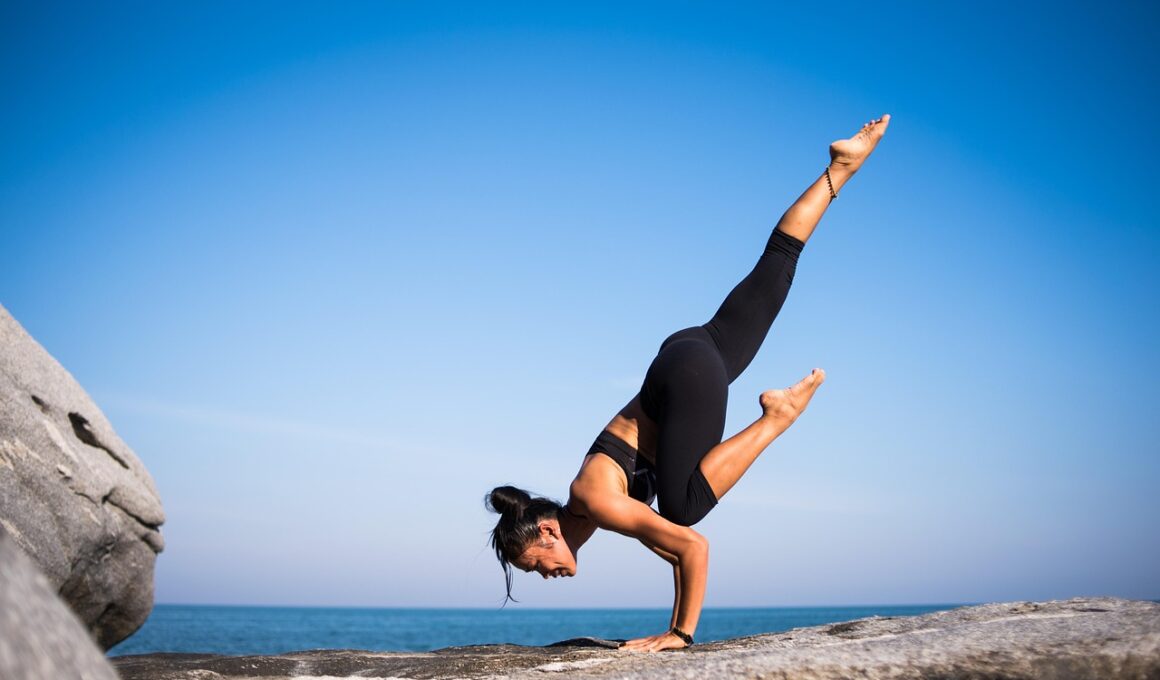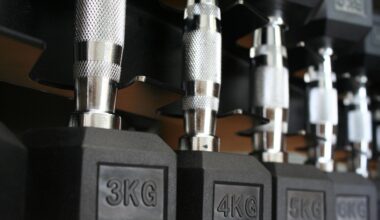Increase Flexibility and Strength with Yoga-based Bodyweight Moves
Bodyweight exercises, especially when combined with yoga dynamics, can significantly enhance your flexibility and strength. Yoga provides a mindful approach that complements bodyweight movements, enabling better balance and coordination. Incorporating yoga into your training fosters a connection between the mind and body, making movements purposeful. The beauty of yoga-based bodyweight exercises is accessibility; you can perform them anywhere, making them ideal for travelers and busy individuals. Each move encourages self-discovery and fosters a greater understanding of your body’s capabilities. For instance, simple poses like the downward dog or warrior pose serve as excellent bodyweight exercises targeting multiple muscle groups. By focusing on deep breathing while flowing through these poses, you not only build strength but also improve your endurance. Enhanced flexibility reduces injury risk and elongates muscle fibers, leading to better performance overall. Moreover, yoga teaches us patience and resilience, which are key attributes that aid in achieving fitness goals. Practicing regularly helps realign your body and achieve a holistic state of well-being. Therefore, integrating yoga-based bodyweight exercises into your fitness routine can reap a multitude of benefits, transforming your body and mind altogether.
The Benefits of Combining Yoga with Bodyweight Training
Many people overlook the synergy between yoga and bodyweight training. When these practices merge, they unlock numerous benefits that can revolutionize your fitness journey. First, this combination enhances flexibility, allowing muscles to stretch and elongate while reducing tightness and tensions. Secondly, yoga encourages proper alignment and form during bodyweight exercises, enhancing their effectiveness. This improved posture protects your joints and mitigates the risk of injuries during workouts. Additionally, yoga promotes mindfulness, teaching you to listen to your body and its limits, which prevents overexertion. This vital aspect of self-awareness leads to a more sustainable fitness journey. By focusing on breath control, you learn to connect each movement with your breath, cultivating endurance and resilience. Furthermore, these workouts also contribute to mental clarity and emotional well-being, as stress decreases and relaxation increases. Often, they culminate in a state of calm and tranquility, fostering lasting peace. Incorporating yoga poses enhances bodyweight workouts, creating a holistic regimen that targets both strength and flexibility. Ultimately, this fusion achieves a well-rounded fitness routine, empowering you on your path towards better health and wellness.
To effectively integrate yoga-based bodyweight exercises into your routine, begin with foundational movements. Start with simple poses such as the plank and bridge, which serve as excellent building blocks for strength and flexibility. The plank, a core strength staple, engages your abdominal muscles while promoting stability. Transitioning into the bridge pose enhances hip strength and flexibility, allowing for better mobility. As you become more comfortable, incorporate variations like side planks or raise one leg during the bridge for additional challenges. Look into sun salutation sequences, as they naturally combine multiple poses, enhancing your flow and endurance. Sun salutations encompass poses like downward dog, cobra, and forward fold, creating a synergistic effect that builds strength in your upper and lower body. This flow not only strengthens but also improves flexibility in a single sequence. Always focus on your breath during these moves, allowing long, deep inhales and exhales. Breathing facilitates movements’ ease and promotes mindfulness. Progress gradually by increasing repetitions or extending hold durations, ensuring to listen to your body’s signals. Consistently working on these movements ensures noticeable improvements in strength and flexibility over time.
As you advance in your yoga-based bodyweight practice, diversity becomes vital to prevent plateaus. Explore different styles to keep your workouts engaging and challenging. Consider trying Vinyasa or Power yoga, which emphasizes dynamic movement and strength. These sequences incorporate bodyweight forms while maintaining a strong emphasis on breath and flow. You may also want to engage in balance poses like tree pose or crow pose. Balance poses solidify your core while challenging your coordination. Furthermore, introducing props such as blocks or straps can enhance your practice, allowing deeper stretches and more extensive range of motion. The use of props encourages a fuller engagement of your muscles while helping to maintain correct alignment. To further amplify your bodyweight movements, explore the addition of compound exercises. For example, combining yoga with push-ups or squats can deliver an intense workout that builds overall strength. Additionally, allocate time for restorative poses to allow muscle recovery post-training. Following up with savasana or child’s pose aids relaxation. Ultimately, maintaining variety and progressive challenges is key to enhancing your practice and ensuring continued growth toward your fitness goals.
Creating a Routine for Optimal Results
Establishing a structured routine is crucial for optimal results with yoga-based bodyweight exercises. Set a schedule that allows for consistency while also incorporating rest days for recovery. Typically, a balanced routine includes three to four days of strength and flexibility workouts. Incorporating warm-up sessions with gentle stretches prevents injury and prepares your body for movement. On strength days, focus on full-body sessions, including leg raises, triceps dips, and yoga poses. Plan your routines to target specific muscle groups while balancing strength and flexibility each week. For instance, alternate between lower body and upper body workouts to ensure each muscle group receives focused attention. Flexibility days may include yin yoga or deep stretching sessions to elongate tight muscles further and improve elasticity. The use of a yoga wheel or foam roller during flexibility sessions can enhance depth in stretching. Remember to incorporate warm-ups and cooldowns into every workout to promote recovery and flexibility, ensuring a holistic approach to your practice. Recording your progress can also be incredibly motivating; keep a journal or use an app to track improvements in strength and flexibility.
Nutrition and hydration play a pivotal role in supporting your yoga-based bodyweight regimen. To fuel your workouts, prioritize a balanced diet rich in whole foods, including plenty of fruits, vegetables, lean proteins, and healthy fats. Consuming sufficient protein fosters muscle recovery and growth, essential after bodyweight training. Hydration is equally vital; staying adequately hydrated enhances performance and promotes overall health. Aim to drink water before, during, and after workouts to replenish lost fluids. As yoga emphasizes mindfulness, consider integrating this principle into your eating habits, practicing mindful eating to help regulate portion sizes and promote digestion. Pay attention to your body’s hunger and fullness cues, fostering a healthier relationship with food. Attempt meal prepping to save time and ensure you have nutritious meals ready, supporting your goals. Consistency in both nutrition and exercise has a compounding positive effect over time. Educate yourself about adequate nutrient intake leading up to your workouts to optimize performance. Ultimately, aligning your nutrition with your practice lays a strong foundation for achieving strength and flexibility through yoga-based bodyweight exercises.
In summary, the fusion of yoga with bodyweight exercises provides powerful tools for improving both flexibility and strength. This combination encourages growth, mindfulness, and resilience within your fitness journey. Consistently practicing these movements brings about improvements in physical fitness while promoting mental clarity and emotional well-being. By adopting various poses, incorporating diverse techniques, and maintaining a schedule, you’ll see progress that inspires further commitment. Pay attention to nutrition, hydration, and recovery for holistic growth. To sustain motivation, keep track of your progress, acknowledge your achievements, and celebrate milestones along your journey. Embrace the process, as fitness is not solely about reaching a destination. Stand firm in your commitment to improving flexibility and strength through yoga-based bodyweight moves. The integration of these practices leads to long-lasting benefits, both physically and mentally. Share your experiences with others who share similar interests, fostering community engagement. By supporting one another, you uplift your practice and inspire others towards their health and fitness goals. Continue exploring new styles and incorporating changes to challenge the body and mind. Your practice is uniquely yours, and the possibilities are endless when you commit to growth through yoga and bodyweight training.


